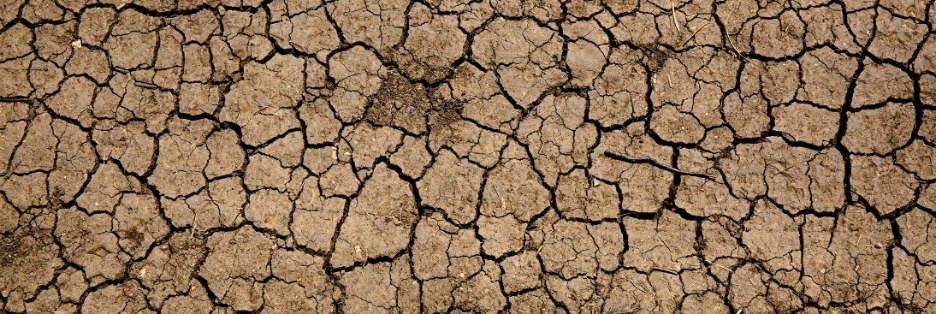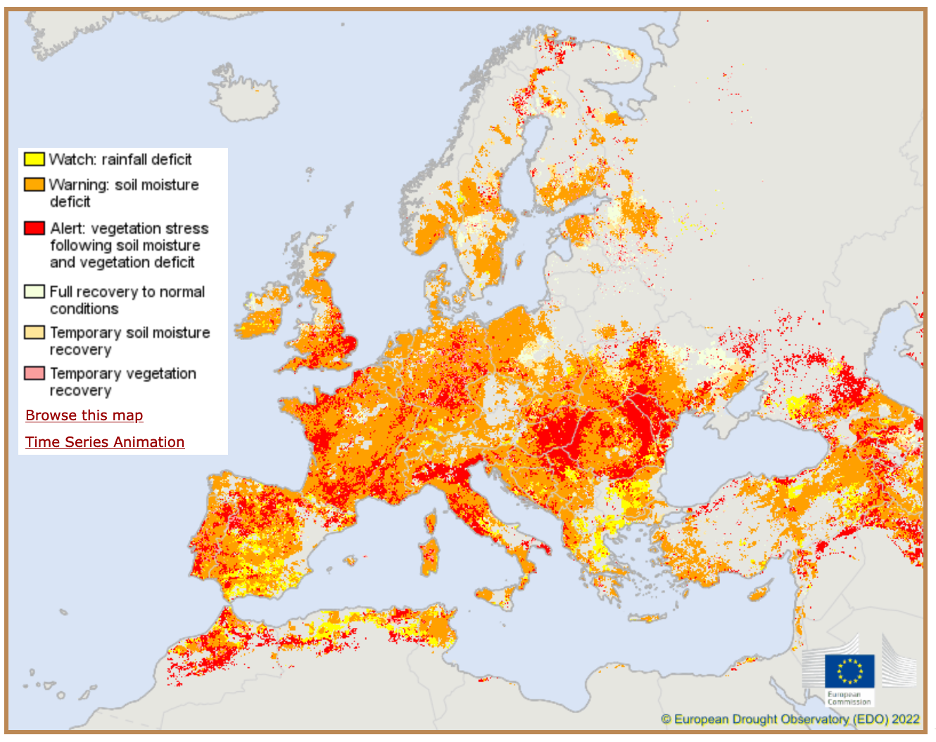While nearly 45% of the U.S. faces drought conditions, Europe is experiencing what some experts say is the worst drought in 500 years. These devastating events – which some evidence shows are on the rise and increasing in intensity as a result of climate change – not only increase the likelihood of catastrophic wildfires, which have other tremendously damaging effects on ecological systems and communities at large, but can also seriously impact agriculture and food production. In Europe, wildfires have burned crops and communities, and drought has reduced production of grain maize, soybeans and sunflowers by 16%, 15% and 12%, respectively. In the U.S., the 17 states most impacted by drought this year represent nearly half of the nation’s $364 billion in agricultural production by value, according to a recent American Farm Bureau report. This production value is not the only thing at risk, says the American Farm Bureau, so are the “stability of farms, ranches and local economies reliant on crops, livestock and downstream products and services for income.” The intensity of this year’s droughts around the world has us thinking a lot more about water, why farms seem to be increasingly susceptible to severe weather, how regenerative agriculture can help address this, and the role of capital.
European Drought Conditions – August 2022
Damaging Impacts of Industrial Agriculture on Water Resources
Decades of industrial agriculture have degraded our soils and made farms more susceptible to extreme weather. The following industrial farming practices can degrade soil biology and soil structure, impairing its ability to manage extreme weather events, such as drought or flooding:
Leaving the ground exposed and fallow for long periods: Farmers often leave fields to fallow when crops are not in season or when they want to give the land time to rest, recover, or break pest cycles. However, leaving the soil bare can expose it to strong winds, hard rains, and flowing water, all of which can lead to erosion and loss of essential soil nutrients that exist in the topsoil. In addition, roots and top growth from plants help build soil organic matter (SOM), so leaving land bare can reduce SOM in the soil.
Heavy tillage: Tilling soil serves to break up the soil and make the soil more manageable for planting and can also be used to manage weed growth. However, tillage can break up soil structure, speed the decomposition and loss of organic matter, and increase the threat of erosion. It also often requires the use large equipment which can break down soil structure, leading to soil compaction, which decreased the soils’ ability to retain water well and leaves fields susceptible to both flooding and drought.
The use of synthetic chemical inputs: Intensive farming relies on synthetic chemical inputs to increase productivity and yield or reduce pests. Studies show these chemicals kill soil organisms that are critical to building healthy soil and soil organic matter. The latter is a key component to helping soils retain water. Therefore, chemical inputs reduce the soil’s water retention capabilities, making it more susceptible to drought conditions and less able to capitalize (through water retention) on the wet weather events.
*As a side note on chemical inputs and water: when it rains, excess water carries soil and any excess inputs in the soil from the fields to nearby waterways. If these excess inputs are toxic – for example nitrogen-rich fertilizers or other chemical herbicides or pesticides – then the waterways themselves get polluted. One of the most devastating examples of this is in the Gulf of Mexico, where there is a 3,275 square mile dead zone caused by decades of run-off from Midwest farms (*down from 8,776 square miles in 2017). This dead zone reduces oxygen to a level that can no longer sustain marine life, decreasing biodiversity. These same chemicals can also impact drinking water when they leach into drinking water, causing human health concerns.
The Gulf of Mexico Dead Zone, 2022

Regenerative Agriculture’s Opportunity
Transitioning from industrial production practices to regenerative agricultural principles, which include continuous soil cover, minimizing soil disturbance, increasing biodiversity, maintaining a living root, and integrating livestock, can help improve water quantity and quality by:
- Reducing chemical inputs
- Increasing soil water retention
A main objective of regenerative agriculture is to build a production system that regenerates soil life, so by default chemical inputs that can harm or kill soil or other life are something that should be reduced and to the extent possible, eliminated from use. Regenerative practices build soil organic matter (SOM), which improves soil’s ability to hold water. In fact, increasing SOM by 1% can increase a soil’s ability to hold water by 20,000 gallons per acre, according to the USDA NRCS. In addition, soil compaction can be reduced by minimizing soil disturbance, for example by reducing tillage that requires heavy equipment, which can lead to improved soil structure with pores that can better retain water.
As regenerative systems are adopted, research shows that overall resilience to weather and climate challenges can be achieved. Evidence of this can be seen in Rodale Institute’s 30-year, side-by-side field studies, that compare organic and conventional agriculture. A 2020 EIT Food article explains that in stressful conditions, particularly during droughts, the organic fields perform better because they are more resilient. This is because the soil contains more biomass and can therefore absorb more water.
How Can Capital Play a Role in Enabling These Benefits?
Capital can play a significant role in activating the benefits of regenerative agriculture on weather and climate resilience by enabling farmer adoption of regenerative practices and by the creating of tools that will lead to reduced chemical inputs and run-off, increase soil water-holding capacity, and build overall systems resilience. Here are some of the investment pathways that can facilitate this:
Farm Financing and Working Capital: Providing capital to reduce the financial risk involved with trying new on-farm practices that lead to increased resilience can help remove one of the biggest barriers to the adoption of regenerative agriculture. We dig into the role of debt financing in fueling regenerative agriculture in this May article on the topic.
Investment in Technology that Facilitates Transition Away from Chemical Inputs: The booming biologicals market is ripe with emerging technologies that use biology – living organisms, plants, beneficials, animals, and microorganisms – to unleash the power of soil. Biofertilizers, for example, use living microorganisms to promote plant growth by increasing the supply or availability of primary nutrients to soil. These types of products hold great potential for helping growers reduce their use of more synthetic input alternatives that are more harmful to soil life and more toxic to water resources.
Investment in Drought Tolerant Crops and End-Products: We shared a story in last week’s RFSI News that explored the under-invested space of climate-adaptation – the main point being, if climate change is a reality for the foreseeable future, we need to invest in not just reducing it and eliminating it, but also in adapting to this new reality. Drought tolerant crops, such as millet and sorghum, present another strategy for farmers to adapt their production to new, drier climates. Investments in working capital to make the on-farm transition, as well as into supply chain infrastructure and CPG brands that will utilize these crops will enable adoption. Snacktivist Foods is a great example of a small and growing CPG company that uses regeneratively grown ancient grains and drought tolerant crops in their baking mixes.
Investment in Reforming Agricultural Policy: Current agricultural policy in the U.S. is designed to serve the commercial farmer who grows conventionally. But if done right, policy has a significant role to play in incentivizing transition to regenerative production methods. While 2022 has already brought some evidence of policy advancement (and public funding) toward regeneration, there is still much policy work left to do. The Regenerate America initiative is one group working to advance regenerative agriculture and soil health in the 2023 Farm Bill and the Funders for Regenerative Agriculture (FORA) U.S. Policy Working Group put together a report, U.S. Policy & Regenerative Agriculture, to help inform this effort.
But this can’t be it! What are we missing? How else can capital unlock agricultural resilience to extreme weather? Please share your thoughts with us here so we can add them to the list!
Sarah Day Levesque is Managing Director at RFSI & Editor of RFSI News. She can be reached here.

